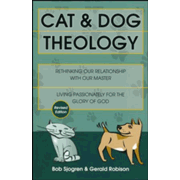“Cat and Dog Theology” was developed to help Christians rethink their relationship with God and understand the importance of giving God priority over ourselves. Bob Sjogren and Gerald Robison have been developing and presenting the concept for many years. The core book, Cat and Dog Theology, was first published in 2003. That book has been updated and revised, and to it have been added additional resources. Of particular interest to homeschoolers is the Cat and Dog Theology Bible Curriculum by Bob and Debby Sjogren that was published in 2013.
The curriculum has five components: Cat and Dog Theology book, Bible Curriculum Workbook for Students: Year 1, Cat and Dog Prayer book, an answer key, and the You Teach3 Cat and Dog Theology PowerPoint CD. You can purchase the curriculum either as a set or as individual items.
Designed for students in grades 7 through 12, the curriculum should take 30 weeks to complete with students spending 30-45 minutes per lesson three days per week. Most weeks include an optional bonus lesson, generally listening to an online lesson with no written work.
For most weeks, lessons follow the same format. The first two lessons of the week assign pages to read in the full-color, illustrated workbook and in either Cat and Dog Theology or Cat and Dog Prayer. Students answer questions about their reading directly in the workbook and they complete a Bible study. On the third lesson each week, students read a cartoon that illustrates the lesson concept then answer questions. They read a brief story about teenage characters in life situations and answer questions. Teens are likely to find both the cartoons and the stories interesting. A quiz with multiple-choice and true/false questions assesses what they've learned. The week's lessons conclude with a personal application reflection that asks students to write in the space provided in their workbook what they intend to do differently as a result of what they've learned.
As you can see from the flow of the lessons, this curriculum is very much directed towards life changes.
The basic concept of “cat and dog theology” is the idea that spiritually we might be more like cats than dogs. Cats tend to consider themselves the center of the universe with everyone else responding to their needs and desires. Most dogs, on the other hand, live to serve and please their masters. This analogy is developed and explored in depth throughout the entire curriculum. The goal is to help Christians understand that their purpose is to glorify God rather than satisfy their own goals and desires. The authors point out that Christians are often somewhere between the two extremes of cat and dog behavior. They are careful to say that cats are not wrong in their theology but incomplete. God does love them and wants to give them good gifts. And we should pray for personal needs. But that's only part of a healthy spiritual relationship—and not the primary part.
Theologically, the entire presentation is premised on a belief in eternal security. The authors don't appear to think that even extreme cat behavior can result in a loss of salvation. If you don't believe in eternal security you'll find yourself questioning some statements in the curriculum. But that theological controversy shouldn't undermine the value of the curriculum for most Christians.
In the Year 1 curriculum, students begin by reading Cat and Dog Theology. Once they've grasped the basic ideas in that book, they begin reading Cat and Dog Prayer beginning in lesson 55. This approach helps students start to change their prayer life so that it becomes more centered on God and His will rather than the student's desires.
Since the best way to really learn something is to teach it to someone else, this curriculum builds in two opportunities where the student will teach what they have been learning to at least two other people. PDF slides and scripts for three different presentations are provided on the You Teach3 CD, so students do not have to create the presentation. But they do need to read through it and rehearse the presentation. Students can choose which two of the three presentations they want to use, one in the middle of the year and one at the end. There is also a final exam at the end of the course to provide parents with a concrete form of evaluation.
Students can work through most of the lesson material on their own. However, parents do need to be involved. Obviously, they need to check student answers with the answer key. However, going far beyond that, the authors suggest that parents take the course with their children then discuss lessons as a family. They also suggest gathering with other families working through the curriculum for these discussions. (The authors are trying to encourage formation of “Kennel Communities” of families in geographic areas who can work together. Check the publisher's website for information.) Personally, I think most homeschool families should try to do this together as a family (including children who are old enough), but I suspect gathering a few families together could be quite a challenge.
In addition to participation in discussions, parents are to read the implementation statements students write each week and talk to them about how well they are doing in regard to following through on what they write. The instructions even say that if students are not making those life changes they should stop moving ahead in the curriculum.
At the beginning of the workbook are separate instructions for homeschool students, homeschool parents, Christian school students, and Christian school teachers. These instructions are very helpful, so don't skip them.
UnveilinGLORY plans introduced three more courses since I first wrote this review. The second course, Revealing God's Greatest Glory, teaches that God's revelation is for the whole world. Students will explore other world religions. Year 3, Living for Eternity, explores the difference between grace and works. The fourth course, Anticipating Heaven, has students read the books Heaven Wins by Don Richardson and Heaven by Randy Alcorn.
In summary, the Cat and Dog Theology Bible Curriculum fulfills the need for a Bible study course for junior and senior students, but it is much more purposefully designed to accomplish actual spiritual life changes than are most other Bible curricula that include life application discussions without concrete plans for implementation.











